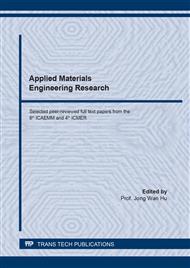[1]
Sun Z. (2017). Mechanical and Thermal Properties of PLA Biocomposites Reinforced by Coir Fibers. Hindawi International Journal of Polymer Science, 2017, 1-8 Retrieved from https://doi.org/10.1155/2017/2178329.
DOI: 10.1155/2017/2178329
Google Scholar
[2]
Stoof, D & Pickering, K. (2018). Sustainable composite fused deposition modelling filament using recycled pre-consumer polypropylene. Composites Part B: Engineering, 135(1), 110-118. Retrieved from https://doi.org/10.1016/j.compositesb.2017.10.005.
DOI: 10.1016/j.compositesb.2017.10.005
Google Scholar
[3]
Siakeng, R, Jawaid, M & Ariffin, H. (2018). The use of Natural Fiber Reinforced Poly Lactic Acid Composites. Polymer Composites, 40, pages 1-19, Retrieved from https://.
DOI: 10.1002/pc.24747
Google Scholar
[4]
Oksman, K.; Skrifvars, M.; Selin, J.F.(2003) Natural fibres as reinforcement in polylactic acid (PLA) composites. Composite Science and Technology, 63, 1317–1324. Retrieve from https://doi.org/10.1016/S0266-3538 (03)00103-9.
DOI: 10.1016/s0266-3538(03)00103-9
Google Scholar
[5]
Song K. (2017). Micro- and Nano-fillers used in the rubber industry. Progress in Rubber Nano Composites, Woodhead Publishing Series in Composites Science and Engineering Pages 41-80. Retrieve from https://doi.org/10.1016/B978-0-08-100409-8.00002-4.
DOI: 10.1016/b978-0-08-100409-8.00002-4
Google Scholar
[6]
Gkartzou, E, Koumoulos, E.P & Charitidis, C.A. (2017). Production and 3D printing processing of bio-based thermoplastic filament. Manufacturing Review EDP Sciences, 4(1), 1-14. Retrieve from https://.
DOI: 10.1051/mfreview/2016020
Google Scholar
[7]
Yu C. (2015). Natural Textile Fiber: Vegetable Fiber. Woodhead Publishing Series in Textiles 2015, Pages 29-56. Retrieve from https://doi.org/10.1016/B978-1-84569-931-4.00002-7.
Google Scholar
[8]
Ebnesajjad, S. (2015). Injection Molding, Fluoroplastics (2nd Edition). 2, pages 236-281. Retrieved from https://doi.org/10.1016/B978-1-4557-3197-8.00010-9.
DOI: 10.1016/b978-1-4557-3197-8.00010-9
Google Scholar
[9]
Sofie S.M. (2016). Methodology of Press System of Compression Molding. UMP Publisher Innovative Engineering. Mechanical System Design. Retrieved from 01 May 2016 Retrieve from https://www.researchgate.net/publication/301754897.
Google Scholar
[10]
Jagushte G.S., Kamble N., Jhadav P., (2017). Fabrication of Pneumatic Compression Molding Machine for FRP Composites. International Research Journal of Engineering and Technology (IRJET), 4(7), 138-143. July 2017 Retrieve from https://irjet.net/archives/V4/i7/IRJET-V4I728.pdf.
Google Scholar
[11]
Matsuzaki, R, Ueda, M & Namiki, M. (2016). Three-dimensional printing of continuous-fiber composites by in-nozzle impregnation. Scientific Reports, 6, Retrieve from https://.
DOI: 10.1038/srep23058
Google Scholar
[12]
Mazzanti et al (2019). FDM 3D Printing of Polymers Containing Natural Fillers: A Review of their Mechanical Properties. Polymers, 11, pages 1-22. Retrieve from https: //doi.org/10.3390/polym11071094.
DOI: 10.3390/polym11071094
Google Scholar
[13]
Dizon et al.(2018). Mechanical characterization of 3D-printed polymers - Review. Additive Manufacturing, 20, page 44-67. Retrieved from https://doi.org/10.1016/j.addma.2017.12.002.
DOI: 10.1016/j.addma.2017.12.002
Google Scholar
[14]
Blanco I. (2020). The Use of Composite Materials in 3D Printing. Journal of Composite Science, 4, 42, 1-22. April 2020. Retrieve from Retrieve from http://.
Google Scholar
[15]
Yang, T.C. (2018). Effect of Extrusion Temperature on the Physico-Mechanical Properties of Unidirectional Wood Fiber-Reinforced Polylactic Acid Composite (WFRPC) Components Using Fused Deposition Modeling. Polymers, 10, pages 1-11. Retrieve from https: //.
DOI: 10.3390/polym10090976
Google Scholar
[16]
Martins C.O, Christian E.C & Fidelis I. I. (2017). Study on Chemical Treatments of Jute Fiber for Application in Natural Fiber Reinforced Composites (NFRPC). International Journal of Advanced Engineering Research and Science (IJAERS), 4(2), 21-26. 9 January, 2020, Retrieve from https://dx.doi.org/10.22161/ijaers.4.2.4.
DOI: 10.22161/ijaers.4.2.4
Google Scholar
[17]
Punyamurthy, R, Sampathkumar, D & Bennehalli, B. (2015). Influence of Fiber Content and Effect of Chemical Pre-Treatments on Mechanical Characterization of Natural Abaca Epoxy Composites. Indian Journal of Science and Technology, 8(11), 1-11. www.indjst.org.
DOI: 10.17485/ijst/2015/v8i11/71768
Google Scholar
[18]
ASTM D7928 (2016). Standard Test Method for Particle-Size Distribution (Gradation) of Fine-Grained Soil Using the Sedimentation (Hydrometer) Analysis. West Conshohocken, PA 19428-2959.
DOI: 10.1520/d7928
Google Scholar
[19]
De Lloyd, D (2000). Delloyd's Chemistry Resources, Reagents and Instrumentation. Retrieve from http://delloyd.50megs.com/index.html.
Google Scholar
[20]
ASTM D2495 Standard Test Methods for Moisture in Cotton by Oven-Drying, West Conshohocken, PA 19428-2959.
Google Scholar
[21]
ASTM C610 Standard Specification for Molded Expanded Perlite Block and Pipe Thermal Insulation, West Conshohocken, PA 19428-2959.
DOI: 10.1520/c0610-07
Google Scholar
[22]
Šafka, J., Ackermann, M., Bobek, J., Seidl, M., Habr, J., & Bĕhálek, L. (2016). Use of Composite Materials for FDM 3D Print Technology. Materials Science Forum, 862, 174–181. Retrieve from https://doi.org/10.4028/www.scientific.net/msf.862.174.
DOI: 10.4028/www.scientific.net/msf.862.174
Google Scholar
[23]
ASTM D695-15, Standard Test Method for Compressive Properties of Rigid Plastics, ASTM International, West Conshohocken, PA, (2015).
Google Scholar
[24]
ASTM D638-14, Standard Test Method for Tensile Properties of Plastics, ASTM International, West Conshohocken, PA, (2014).
Google Scholar
[25]
ASTM D790-15e2, Standard Test Methods for Flexural Properties of Unreinforced and Reinforced Plastics and Electrical Insulating Materials, ASTM, International, West Conshohocken, PA, (2015).
DOI: 10.1520/d0790-99
Google Scholar
[26]
ASTM D256-10e1, Standard Test Methods for Determining the Izod Pendulum Impact Resistance of Plastics, ASTM International, West Conshohocken, PA, (2010).
Google Scholar
[27]
Wu, W, Ye, W & Wu, Z. (2017). Influence of Layer Thickness, Raster Angle, Deformation Temperature and Recovery Temperature on the Shape-Memory Effect of 3D-Printed Poly Lactic Acid Samples. Materials, 10, pages 1-16. Retrieved from https://.
DOI: 10.3390/ma10080970
Google Scholar
[28]
Moradi, M.; Meiabadi, S.; Kaplan, A. (2019). 3D Printed Parts with Honeycomb Internal Pattern by Fused Deposition Modelling; Experimental Characterization and Production Optimization. Met. Mater. Int. 2019, 25, 1312–1325. Retrieve from: https://doi.org/10.1007/s12540-019-00272-9.
DOI: 10.1007/s12540-019-00272-9
Google Scholar
[29]
Caminero M.A (2019). Additive Manufacturing of PLA-Based Composites Using Fused Filament Fabrication: Effect of Graphene Nanoplatelet Reinforcement on Mechanical Properties, Dimensional Accuracy and Texture. Polymers 2019, 11, 799; 04 May 2019. Retrieve from:.
DOI: 10.3390/polym11050799
Google Scholar


